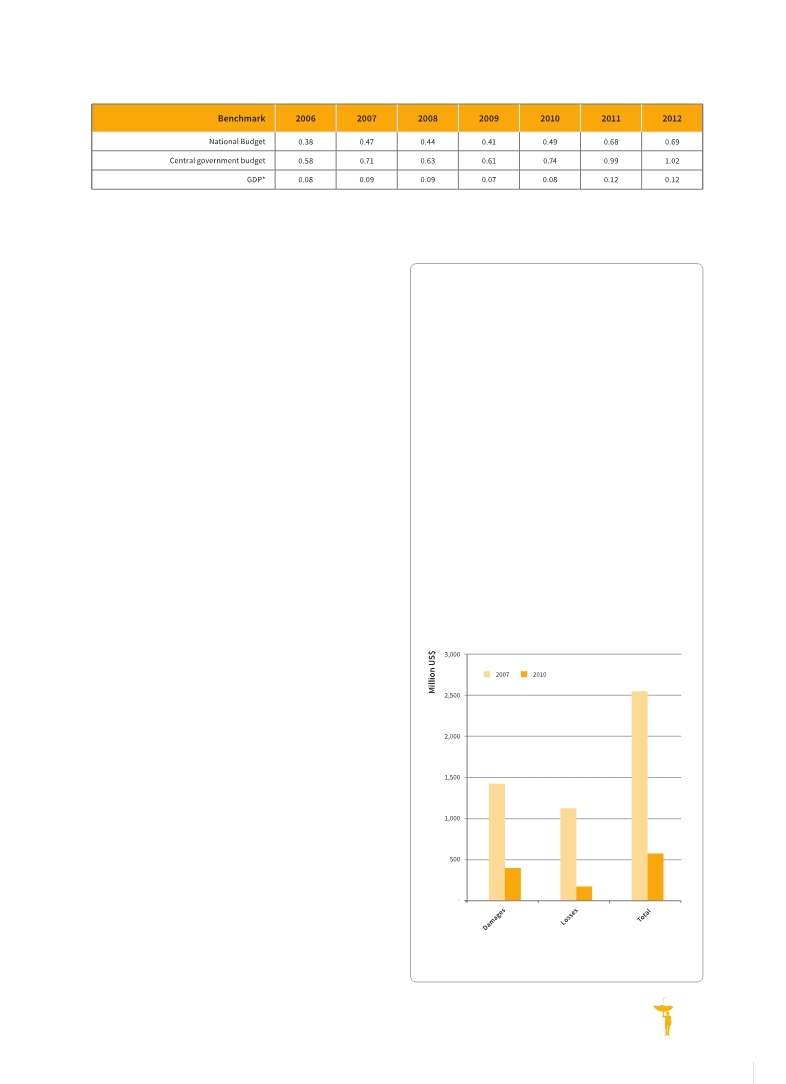 |
Global Assessment Report on Disaster Risk Reduction 2013
From Shared Risk to Shared Value: the Business Case for Disaster Risk Reduction |
 |
Global Assessment Report on Disaster Risk Reduction 2013
From Shared Risk to Shared Value: the Business Case for Disaster Risk Reduction |
|
|


|

221
economy by investing in projects to reduce the vulnerability of communities or public infrastructure to hazards and climate change.
China has also made major investments, for example, US$10.5 billion in flood prevention and drought relief in 2011 by the central government; US$400 million per year for geological disaster prevention and control, with 23 provinces, 176 cities and 932 counties establishing special complementary funds amounting to an estimated US$2 billion since 2011. Central government has also invested just under US$600 million in agricultural disaster prevention and reduction. Its Comprehensive Disaster Prevention and Reduction Plan (2011–2015) aims to reduce direct economic losses from disasters to less than 1.5 percent of GDP.
Reviews of budget allocations also show that in the Philippines, for example, disaster risk reduction investments are trending upward, for example, from 1.4 percent to 2.1 percent of the country’s national budget between 2009 and 2011 (
 Jose, 2012 Jose, 2012 Jose, S.R. 2012.,Preliminary examination of Existing Methodologies for Allocating and Tracking National Government Budget for Disaster Risk Reduction (DRR) in the Philippines., Study developed under the ADB supported RETA 6511 (Regional Stocktaking and Mapping of Disaster Risk Reduction Internventions in Asia and the Pacific).. Jose, S.R. 2012.,Preliminary examination of Existing Methodologies for Allocating and Tracking National Government Budget for Disaster Risk Reduction (DRR) in the Philippines., Study developed under the ADB supported RETA 6511 (Regional Stocktaking and Mapping of Disaster Risk Reduction Internventions in Asia and the Pacific).. Click here to view this GAR paper. In Indonesia, disaster risk reduction allocations almost doubled from 2006 to 2012 (Table 14.1) as a proportion of the national budget. About 75 percent is allocated to (mainly corrective) disaster risk management (
 Darwanto, 2012 Darwanto, 2012 Darwanto, H. 2012.,Understanding Existing Methodologies for Allocating and Tracking National Government Budget for Disaster Risk Reduction in Indonesia., Study developed under the ADB supported RETA 6511 (Regional Stocktaking and Mapping of Disaster Risk Reduction Interventions in Asia and the Pacific).. Darwanto, H. 2012.,Understanding Existing Methodologies for Allocating and Tracking National Government Budget for Disaster Risk Reduction in Indonesia., Study developed under the ADB supported RETA 6511 (Regional Stocktaking and Mapping of Disaster Risk Reduction Interventions in Asia and the Pacific).. Click here to view this GAR paper. More than half of the countries have also reported in the last two HFA review cycles that they specifically incorporate allocations to disaster risk reduction and resilient recovery into their post-disaster recovery budgets. However, only 15 percent are able to report on the percentage of this allocation.
(Source:
 Darwanto, 2012 Darwanto, 2012 Darwanto, H. 2012.,Understanding Existing Methodologies for Allocating and Tracking National Government Budget for Disaster Risk Reduction in Indonesia., Study developed under the ADB supported RETA 6511 (Regional Stocktaking and Mapping of Disaster Risk Reduction Interventions in Asia and the Pacific).. Darwanto, H. 2012.,Understanding Existing Methodologies for Allocating and Tracking National Government Budget for Disaster Risk Reduction in Indonesia., Study developed under the ADB supported RETA 6511 (Regional Stocktaking and Mapping of Disaster Risk Reduction Interventions in Asia and the Pacific).. Click here to view this GAR paper. Table 14.1 Disaster management budget as a percentage of Indonesia’s total budget, 2006–2012 (in percent)
(Source: FONDEN)
Box 14.7 Investments in risk reduction: the case of Tabasco, Mexico
The National Disaster Fund (FONDEN) of Mexico is currently investing between 25 percent and 30 percent of its resources to rebuilding better. These investments in risk reduction can enable significant reduction in disaster losses. The floods in the State of Tabasco in 2007 (UNISDR, 2009
UNISDR. 2009.,Global Assessment Report on Disaster Risk Reduction: Risk and poverty in a changing climate., United Nations International Strategy for Disaster Reduction., Geneva,Switzerland: UNISDR.. . Following the disaster, FONDEN financed a range of studies of the region’s hydrology, urban development and land use, which led to the implementation of an integrated programme of investments to reduce disaster risk.
The value of these investments became apparent during the state’s 2010 floods. Even though rainfall levels in 2010 were comparable with levels in 2007, direct and indirect losses of 2010 were only one-fifth of those in 2007 (Figure 14.8).
Figure 14.8 Comparing losses from floods in 2007 and 2010 in Tabasco, Mexico
|



 |
